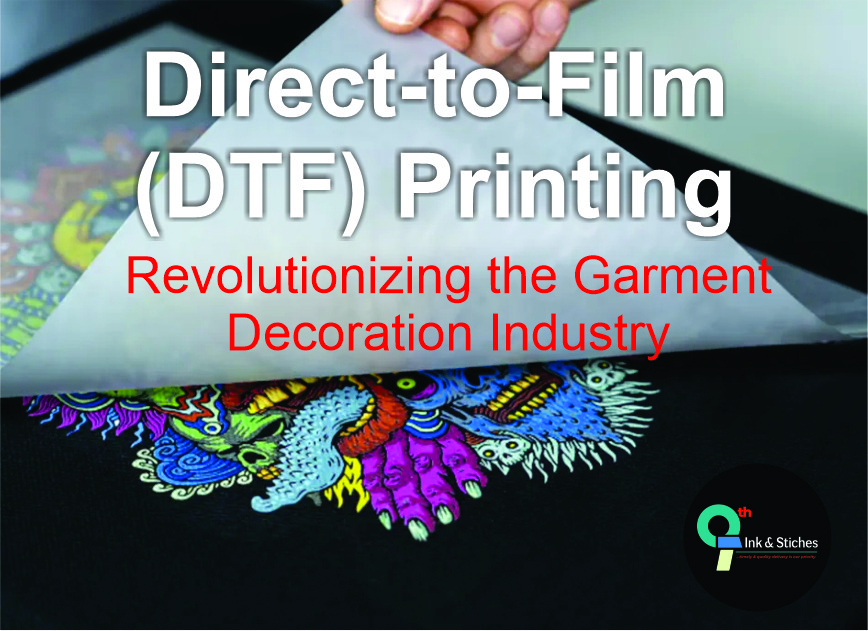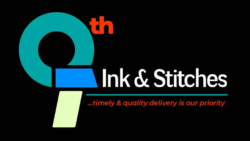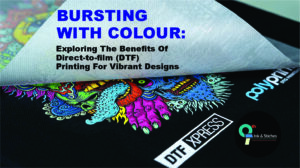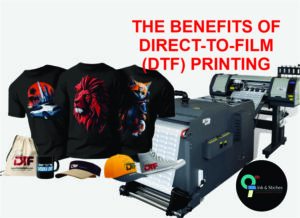
What is Direct-to-Film (DTF) Printing?
Have you ever wondered how those intricate designs on t-shirts are created? Well, let me introduce you to the latest game-changer in the world of garment decoration: Direct to Film (DTF) printing. This innovative technique is taking the industry by storm, offering a unique blend of quality, versatility, and cost-effectiveness that’s hard to beat.
The Basics of DTF Printing
At its core, DTF printing is a process that involves printing designs onto a special film using water-based inks and then transferring that design onto various fabrics. It’s like a high-tech version of those iron-on transfers we used as kids, but with far superior results. The magic lies in its ability to produce vibrant, durable prints on a wide range of materials, from cotton to polyester and everything in between.
How Does DTF Printing Work?
Let’s break down the DTF printing process into simple steps:
- Design Creation: It all starts with a digital design.
- Printing: The design is printed onto a special film using specialized DTF printers.
- Powder Application: A layer of adhesive powder is applied to the wet ink.
- Curing: The film is heated to melt the powder and cure the ink.
- Transfer: The design is then transferred onto the garment using heat and pressure.
Sounds simple, right? But there’s a lot of science and precision involved in each step to ensure top-notch results.
The Rise of DTF Printing in the Garment Industry
A Brief History of Garment Printing
To appreciate the impact of DTF printing, we need to take a quick trip down memory lane. The garment printing industry has come a long way from the days of screen printing and heat transfers. We’ve seen the rise of digital printing methods like Direct-to-Garment (DTG) and sublimation. Each new technique brought its own set of advantages and challenges. But DTF? It’s like the cool new kid on the block that everyone wants to hang out with.
Why DTF is Gaining Popularity
So, what makes DTF printing so special? Well, it’s a bit like having your cake and eating it too. It combines the best features of other printing methods while addressing many of their limitations. Let’s look at some reasons why DTF is becoming the go-to choice for many businesses:
- Versatility: It works on a wide range of fabrics and colors.
- Quality: Produces vibrant, long-lasting prints.
- Cost-effectiveness: Lower setup costs compared to screen printing.
- Speed: Faster turnaround times for small to medium orders.
- Eco-friendliness: Uses water-based inks, making it more environmentally friendly.
The Technology Behind DTF Printing
DTF Printers: The Heart of the Process
At the core of DTF printing are the specialized printers designed for this technique. These aren’t your average office printers – they’re more like the Ferrari of the printing world. DTF printers are engineered to handle the unique requirements of printing on film with water-based inks. They offer precise color management and high resolution to ensure that every detail of your design is captured perfectly.
Key Features of DTF Printers
- High-resolution printing capabilities
- Precise color management systems
- Compatibility with water-based inks
- Ability to handle various film types and sizes
The Magic of DTF Inks
The inks used in DTF printing are a crucial part of the equation. These water-based inks are specially formulated to adhere to the film and then transfer effectively onto the fabric. They’re like chameleons, adapting to different surfaces while maintaining their vibrancy and durability.
Benefits of DTF Inks
- Vibrant colors that pop on any fabric
- Excellent wash resistance
- Eco-friendly composition
- Ability to print on both light and dark fabrics
The Role of Adhesive Powders
Remember that powder we mentioned earlier? It’s not just any powder – it’s a specially designed adhesive that plays a crucial role in the DTF process. When heated, this powder melts and forms a strong bond between the ink and the fabric. It’s like the secret sauce that holds everything together.
Advantages of DTF Printing
Versatility: A Printer’s Dream
One of the biggest selling points of DTF printing is its incredible versatility. It’s like having a Swiss Army knife in your printing arsenal. Whether you’re working with cotton, polyester, blends, or even materials like leather and nylon, DTF has got you covered. This versatility extends to color options too – light, dark, or multicolored fabrics are all fair game.
Quality: Bringing Designs to Life
When it comes to print quality, DTF doesn’t disappoint. The combination of high-resolution printing and vibrant inks results in designs that practically leap off the fabric. It’s capable of reproducing intricate details and smooth color gradients that other methods might struggle with. Imagine being able to print a photo-realistic image on a t-shirt with the same clarity as a high-quality photograph – that’s the level of detail we’re talking about.
Cost-Effectiveness: More Bang for Your Buck
In the world of business, cost is always a consideration. DTF printing shines in this area, especially for small to medium-sized orders. Unlike screen printing, which requires separate screens for each color, DTF can print multiple colors in one go. This means lower setup costs and faster turnaround times. It’s like getting a gourmet meal at fast-food prices – high quality without breaking the bank.
Durability: Prints That Last
Nobody wants a t-shirt design that fades after a few washes. DTF prints are known for their excellent durability. The combination of high-quality inks and the adhesive powder creates a strong bond with the fabric, resulting in prints that can withstand repeated washing and wear. It’s like giving your designs a suit of armor – they’re built to last.
Challenges and Limitations of DTF Printing
Initial Investment: The Price of Innovation
While DTF printing offers many advantages, it’s important to acknowledge that there are some challenges too. One of the main hurdles is the initial investment. DTF printers and the associated equipment can be quite costly. It’s a bit like buying a high-end car – the upfront cost is significant, but the performance and features make it worthwhile in the long run.
Learning Curve: Mastering the Technique
As with any new technology, there’s a learning curve involved in mastering DTF printing. It requires a good understanding of the process, from preparing designs to managing the transfer process. It’s not rocket science, but it does take time and practice to get it right. Think of it like learning to play a new instrument – it takes patience and persistence, but the results are worth it.
Limited Production Volume: Not for Mass Production
While DTF is excellent for small to medium-sized orders, it may not be the most efficient choice for very large production runs. For massive quantities, traditional screen printing might still have the edge in terms of speed and cost-effectiveness. DTF is more like a skilled artisan than a factory assembly line – great for customized, smaller batches, but not designed for mass production.
DTF vs. Other Printing Methods
DTF vs. Screen Printing
Screen printing has been the go-to method for t-shirt printing for decades. It’s like the reliable old workhorse of the industry. But how does DTF compare?
Advantages of DTF over Screen Printing:
- Lower setup costs for small orders
- Ability to print complex, multi-color designs easily
- No minimum order requirements
- Faster turnaround for small batches
Where Screen Printing Still Shines:
- More cost-effective for very large orders
- Slightly more durable prints for heavy-duty use
DTF vs. Direct-to-Garment (DTG)
Direct-to-Garment printing is another digital printing method that’s gained popularity in recent years. It’s like DTF’s cousin – similar in some ways, but with its own unique characteristics.
Advantages of DTF over DTG:
- Works better on a wider range of fabrics
- Generally more vibrant prints on dark garments
- Often more cost-effective for small to medium orders
Where DTG Has an Edge:
- Slightly softer hand feel on the final print
- Can be more efficient for one-off prints
The Future of DTF Printing
Technological Advancements on the Horizon
The world of DTF printing is evolving rapidly. As with any emerging technology, we can expect to see continuous improvements and innovations. Manufacturers are working on developing faster printers, more eco-friendly inks, and more efficient transfer processes. It’s like watching a child grow – DTF is maturing and becoming more sophisticated with each passing year.
Expanding Applications
While DTF is currently primarily used in the garment industry, its potential applications are vast. We’re starting to see it used in other areas such as:
- Home decor (pillows, curtains)
- Promotional products
- Sports equipment
- Automotive interiors
The versatility of DTF means that its use could expand into many other industries in the future. It’s like a blank canvas – the possibilities are limited only by our imagination.
Environmental Considerations
As sustainability becomes increasingly important, the DTF printing industry is likely to focus more on eco-friendly solutions. This could include the development of more biodegradable films, greener inks, and more energy-efficient printers. It’s a bit like the automotive industry’s shift towards electric vehicles – a move towards more sustainable practices driven by environmental concerns and consumer demand.
Conclusion: The DTF Revolution
Direct-to-Film printing is more than just a new technique – it’s a revolution in the garment decoration industry. Its blend of versatility, quality, and cost-effectiveness makes it a compelling choice for businesses of all sizes. While it’s not without its challenges, the advantages of DTF printing far outweigh its limitations for many applications.
As we look to the future, it’s clear that DTF printing will continue to evolve and improve. Whether you’re a small business owner looking to start a custom t-shirt line, or a large corporation seeking efficient solutions for promotional products, DTF printing offers exciting possibilities.
The printing industry has always been about bringing ideas to life, and DTF is the latest tool in this ongoing quest. It’s opening up new avenues for creativity and entrepreneurship, allowing more people to turn their design dreams into reality. As we move forward, one thing is certain – the world of garment decoration will never be the same again, thanks to the DTF revolution.



